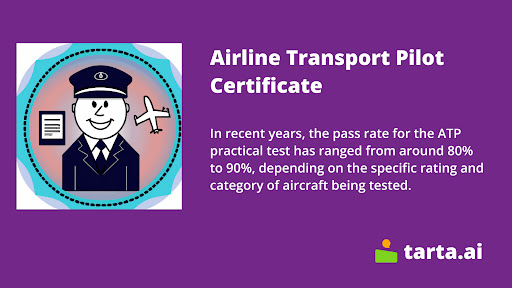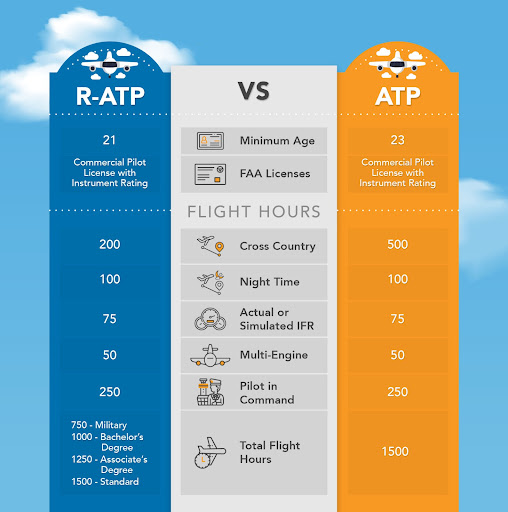The Importance of Airline Transport Pilot Certificate (ATP): Main Points

PHOTO: Lukas Gojda:Kesu
What is an Airline Transport Certificate?
The Airline Transport Pilot certificate (ATP) is the highest level of pilot certification issued by the Federal Aviation Administration (FAA) in the United States. It qualifies a pilot to operate as the pilot-in-command (PIC) of an aircraft in air carrier operations, such as scheduled airline service or air cargo transportation.
To obtain an ATP certificate, a pilot must have a minimum of 1,500 hours of flight time, including 500 hours of cross-country flight time, 100 hours of night flight time, and 75 hours of instrument flight time. In addition, the pilot must meet other requirements, such as passing written and practical tests, and meeting medical and age requirements.
The ATP certificate is required for pilots who fly for Part 121 air carriers (scheduled airlines), Part 135 air carriers (charter and on-demand operations), and for some other types of aviation operations, such as corporate flight departments and government agencies.
How Long Does It Take to Earn an ATP Certificate?
The time it takes to earn an Airline Transport Pilot (ATP) certificate varies depending on a number of factors, such as the pilot's experience, training schedule, and availability. Here are the general steps and estimated timelines for obtaining an ATP certificate:
- Meet the eligibility requirements: A pilot must meet the minimum flight time requirements, pass a medical exam, and obtain a private pilot certificate and instrument rating before beginning ATP training. This can take several months to several years, depending on the pilot's experience and availability.
- Complete ATP ground school: The ATP ground school is a comprehensive course that covers topics such as aircraft systems, weather, regulations, and crew resource management. This course typically takes 2-3 weeks to complete, depending on the training program and schedule.
- Obtain ATP flight training: The ATP flight training includes simulator training and flight time in a multi-engine aircraft. The FAA requires a minimum of 30 hours of flight time, but most training programs include additional flight time to ensure that pilots are adequately prepared. The length of ATP flight training can vary from several weeks to several months, depending on the program and the pilot's schedule.
- Pass the ATP written exam: Before taking the practical test, a pilot must pass the ATP written exam, which covers topics such as aircraft performance, weather, navigation, and regulations. The exam can be taken at an FAA-approved testing center and typically takes several hours to complete.
- Pass the ATP practical test: The ATP practical test consists of a flight exam and an oral exam with an FAA examiner. The flight exam typically takes several hours to complete, and the entire practical test can take a full day or more.
Overall, the time it takes to earn an ATP certificate can range from several months to several years, depending on the pilot's experience, training program, and availability.
What are the minimum requirements for enrollment?
To be eligible to enroll in an Airline Transport Pilot (ATP) training program, a pilot must meet the following minimum requirements:
- Age: The pilot must be at least 23 years old to obtain an ATP certificate.
- Flight Experience: The pilot must have a minimum of 1,500 hours of flight time, including at least 500 hours of cross-country flight time, 100 hours of night flight time, and 75 hours of instrument flight time. In addition, the pilot must have logged at least 250 hours as pilot-in-command (PIC) of a fixed-wing aircraft.
- Education: There are no specific educational requirements to obtain an ATP certificate, but most airlines and training programs require a bachelor's degree or equivalent experience.
- Medical Certificate: The pilot must hold a first-class medical certificate issued by an FAA-approved medical examiner.
- English Proficiency: The pilot must be able to read, write, speak, and understand the English language.
- Other Requirements: The pilot must pass a written exam and a practical flight exam with an FAA-approved examiner, and must meet other requirements such as background checks and security clearances.
It's important to note that these are just the minimum requirements for enrolling in an ATP training program, and that most airlines and training programs have additional requirements beyond those set by the FAA.
NOTE:
ATP training can be expensive, so it's important to consider financing options such as loans, scholarships, or employer-sponsored training programs. Make sure to research and compare the costs and terms of different financing options.

What are the lifehacks to prepare for an Airline Transport Pilot (ATP) certificate?
Preparing for an Airline Transport Pilot (ATP) certificate is a significant undertaking, requiring a significant amount of time, effort, and money. Here are some life hacks to help you prepare for an ATP certificate:
- Create a study plan: Make a study plan that includes regular study sessions and a timeline for completing the necessary training and testing. Your study plan should be realistic and tailored to your individual needs.
- Study materials: Get access to the required study materials, such as FAA handbooks, flight manuals, and study guides. These materials are essential for learning the concepts and procedures that you will need to know for the ATP exam.
- Practice flying: Get as much flight experience as possible. The more time you spend in the cockpit, the more comfortable you will become with the airplane and the more confident you will be in your abilities.
- Study in groups: Find other pilots who are preparing for the ATP certificate and form a study group. Studying in groups can help you stay motivated and can provide an opportunity to discuss and learn from each other.
- Use technology: Use technology to your advantage. There are several apps and online resources available that can help you with studying for the ATP certificate. For example, there are online flashcards and study guides that you can access from your computer or phone.
- Take practice exams: Take practice exams to help you assess your readiness for the actual ATP exam. You can find many practice exams online or in study guides. These exams can help you identify areas where you need more practice and can help you build your confidence.
- Stay healthy: Finally, remember to take care of yourself physically and mentally. Flying can be stressful, and it's essential to maintain a healthy lifestyle to be in optimal condition to fly. Get enough sleep, eat well, and exercise regularly.
Preparing for an ATP certificate is a significant undertaking, but with the right approach and dedication, you can achieve your goal.
Tip:
Stay up-to-date on FAA regulations and requirements related to the ATP certificate. This includes staying informed about changes to regulations, studying the latest FAA handbooks and publications, and attending training sessions or seminars.
What is restricted ATP?
The Restricted Airline Transport Pilot (R-ATP) is a type of ATP certificate that has some additional eligibility requirements and limitations compared to a regular ATP certificate.
To qualify for an R-ATP certificate, a pilot must have completed a specific amount of flight training and education hours from an approved institution. The requirements for R-ATP are less than the traditional ATP certificate, as the R-ATP has fewer minimum flight hours than the ATP certificate.
Here is a table summarizing the requirements for a Restricted Airline Transport Pilot (R-ATP) certificate:
Requirement | Four-year degree | Two-year degree | Bachelor's degree with flight training | Military pilot |
Total flight time | 1,000 hours | 1,250 hours | 1,000 hours | 750 hours |
Cross-country flight time | 200 hours | 200 hours | 200 hours | 200 hours |
Night flight time | 100 hours | 100 hours | 100 hours | 100 hours |
It's important to note that these are the minimum requirements, and additional qualifications and experience may be required by individual airlines or training programs.

PHOTO: AeroGuard
What Can I Do With a Restricted ATP?
With a Restricted Airline Transport Pilot (R-ATP) certificate, a pilot can work as a co-pilot for a Part 121 air carrier (an airline operating scheduled flights with aircraft that have a seating capacity of 10 or more passengers) with less than the full 1,500 hours of flight time required for a regular ATP certificate.
However, it's important to note that not all airlines accept R-ATP certificates, and individual airlines may have their own requirements for hiring pilots. Some airlines may require a full ATP certificate with 1,500 hours of flight time, while others may have additional requirements such as a specific type of flight experience or additional certifications.
Additionally, pilots with R-ATP certificates can also use their certification to work in other areas of aviation, such as corporate flying, charter operations, and flight instruction. In these roles, pilots can build flight hours and gain additional experience to meet the requirements for a full ATP certificate.
Ultimately, the R-ATP certificate is a stepping stone toward a career as an airline pilot, but additional training and experience will be necessary to meet the requirements of individual airlines and advance in the profession.
What is ATP CTP?
ATP CTP stands for Airline Transport Pilot Certification Training Program. It is a comprehensive training program that is required by the FAA (Federal Aviation Administration) for all pilots seeking an Airline Transport Pilot (ATP) certificate.
The ATP CTP program covers a wide range of topics related to airline operations and includes both ground school and simulator training. The program is designed to prepare pilots for the increased responsibilities and complexities of flying for a Part 121 air carrier (an airline operating scheduled flights with aircraft that have a seating capacity of 10 or more passengers).
The ATP CTP program includes training in the following areas:
- Aerodynamics and aircraft systems
- Meteorology and weather theory
- Navigation and flight planning
- Crew resource management (CRM) and communication
- High-altitude operations and pressurization
- Emergency procedures and abnormal situations
- FAA regulations and procedures
- Standard operating procedures (SOPs) and airline policies
The ATP CTP program typically takes five days to complete and includes both classroom instruction and simulator training. Upon completion of the program, pilots are issued a certificate of completion, which is required to be presented to the FAA when applying for an ATP certificate.
It's important to note that the ATP CTP program is separate from the actual ATP training, which includes additional flight training and testing. The ATP CTP program is intended to provide a foundation of knowledge and skills that pilots will build upon during their ATP training.
What benefits can an Airline Transport Pilot (ATP) certificate bring to you?
Obtaining an Airline Transport Pilot (ATP) certificate can be very useful for pilots who want to pursue a career in commercial aviation. An ATP certificate is the highest level of certification for pilots, and it is required for pilots who want to work as a pilot-in-command for a Part 121 air carrier (an airline operating scheduled flights with aircraft that have a seating capacity of 10 or more passengers).
- Career Advancement: An ATP certificate is necessary for pilots who want to work for a Part 121 air carrier as a pilot-in-command, which is often seen as the pinnacle of a commercial pilot's career.
- Higher Earnings Potential: Pilots with an ATP certificate generally earn higher salaries than those with lower-level certifications, especially if they are employed by major airlines.
- Increased Job Opportunities: An ATP certificate opens up many more job opportunities in the aviation industry, including working for major airlines, cargo carriers, and charter operations.
- Enhanced Skills and Knowledge: The training and experience required to obtain an ATP certificate provide pilots with a deep understanding of aviation safety, aircraft systems, and complex flight operations.
- Personal Accomplishment: Obtaining an ATP certificate is a significant achievement for pilots, representing years of hard work, dedication, and commitment to the profession.
Overall, obtaining an ATP certificate is an important step for pilots who are serious about pursuing a career in commercial aviation, and it offers many benefits in terms of career advancement, earnings potential, and personal accomplishments.
- An Airline Transport Pilot (ATP) certificate is the highest level of certification for pilots, and it allows them to fly for a Part 121 air carrier (an airline operating scheduled flights with aircraft that have a seating capacity of 10 or more passengers).
- To be eligible for an ATP certificate, a pilot must have a minimum of 1,500 hours of flight time, including specific amounts of cross-country, night, and instrument flight time. Additionally, the pilot must hold a Commercial Pilot certificate and have logged at least 250 hours as pilot-in-command (PIC) of a fixed-wing aircraft.
- A Restricted Airline Transport Pilot (R-ATP) certificate allows pilots to work as a co-pilot for a Part 121 air carrier with less than the full 1,500 hours of flight time required for a regular ATP certificate. However, not all airlines accept R-ATP certificates, and individual airlines may have their own requirements for hiring pilots.
- The Airline Transport Pilot Certification Training Program (ATP CTP) is a comprehensive training program that is required by the FAA for all pilots seeking an ATP certificate. The program covers a wide range of topics related to airline operations and includes both ground school and simulator training.
- Building flight experience and flight hours is a critical part of becoming eligible for an ATP certificate. Pilots typically work as flight instructors, fly charter or corporate aircraft, or work in other roles in the aviation industry to gain the necessary experience.
- Additional qualifications and experience may be required by individual airlines or training programs, and it can take several years of flying and building experience to reach the required 1,500 hours of flight time for an ATP certificate.
FAQ
What is an Airline Transport Pilot certificate (ATP)?
It's the highest level of certification for pilots to operate larger aircraft and serve as pilot-in-command
What are the requirements to obtain an ATP certificate?
Minimum 1,500 flight hours, including 500 cross-country hours, multi-engine and instrument flight experience, and passing written and practical exams.
What are the benefits of having an ATP certificate?
It allows a pilot to apply for major airline positions and is a sign of high skill and professionalism.
How long does it take to obtain an ATP certificate?
It varies depending on individual circumstances, but can take several months to a few years.
What type of training is required to obtain an ATP certificate?
Training includes ground school, simulator sessions, and flight training in various aircraft.